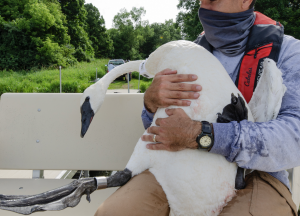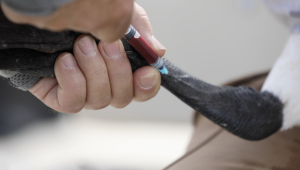Three Rivers Park District Part of New Trumpeter Swan Research Project
The trumpeter swan is the poster bird for successful reintroduction of a waterfowl species in the state of Minnesota. In the late 1880s, this bird was all but wiped out in the state. Then in the 1960s, there was a move to reintroduce the majestic bird. Three Rivers Park District was at the forefront.
“In 1966, Three Rivers at that time was called Hennepin County Park Reserve District. They brought in some swans to raise in a captive program,” said John Moriarty, senior wildlife manager with the Three Rivers Park District.
Those initial birds came from Red Rock Lakes National Wildlife Refuge in Montana. For the next two decades the program was relatively small, never getting more than 50 to 60 birds. When the DNR starting bringing in eggs from Alaska in the mid-1980s, the swan population began to take off.
“The original goal was to have a population of 300 to 500 swans and now it’s up over 25,000” said Moriarty.
Today, almost all Three Rivers Park District park reserves have at least one nesting pair of swans on one of its lakes.
New Research Project

To learn more about trumpeter swans, a new collaborative research project is underway with the University of Minnesota, Minnesota DNR, U.S. Fish and Wildlife Service, the Trumpeter Swan Society and Three Rivers Park District.
“The research project that’s going now is to try to figure out the migration patterns of swans. We’re not fully aware of where the majority of the birds are. We could probably tell you where 300,000-400,000 of the birds are. This study will tell us where other birds are migrating and the timing of their migration. Do they only migrate when things freeze up?” said Moriarty.
 And these days everyone is interested in their family history. The collaboration does a little ancestry research on swans as well. The researchers will collect blood from swans to look at their genetics.
And these days everyone is interested in their family history. The collaboration does a little ancestry research on swans as well. The researchers will collect blood from swans to look at their genetics.
“We can look at genetics to see what percentage of the bloodline is from the Alaska birds, what percentage is from the Montana birds,” said Moriarty.
And finally, the researchers will be looking at lead levels in the birds because it’s still an issue for waterfowl.
GPS Surveillance
But the coolest part of the project, according to Three Rivers Park District researchers, are using radio collars to track the birds.
“It’s actually a solar-powered radio that collects GPS units every 15 minutes and then once a day it downloads to a cell tower,” said Moriarty.
The researchers are looking at collaring 35 birds in Minnesota and another 40 birds scattered from Iowa, Michigan, Ohio and Manitoba. Each one of the radio collars costs about $1,500. The project is funded by the Minnesota Environment and Natural Resources Trust Fund. Groups like the Trumpeter Swan Society and other states are also buying radio collars.
Brooklyn Center | Brooklyn Park | Crystal | Golden Valley | Maple Grove | New Hope | Osseo | Plymouth | Robbinsdale


